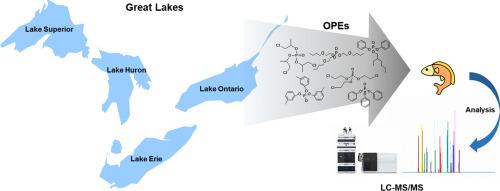Science of the Total Environment ( IF 9.8 ) Pub Date : 2021-10-16 , DOI: 10.1016/j.scitotenv.2021.150981 Yeowool Choi 1 , Chunyan Hao 2 , Paul A Helm 3 , Satyendra P Bhavsar 3 , Sang Don Kim 1

|
Organophosphate esters (OPEs) are flame retardant and plasticizer chemicals added to electronics, furniture, textiles, and other building materials and consumer products. In this study, fillets of fish often caught by anglers in the North American Great Lakes, Lake Trout (Salvelinus namaycush) across four Great Lakes and nearshore fish species near the large urban and industrial centers of Toronto and Hamilton, Canada, were analyzed for 22 OPEs. A rapid microextraction of homogenized tissues with methanol dramatically reduced preparation and sample handling time while achieving recoveries of 69–141%, and the optimized liquid chromatographic separation improved isomeric separations, including aryl-OPEs. Twelve of the 22 OPEs were detected, with frequencies of detection ranging from 8.3% to 98%, and five compounds were detected in >50% of the fish. The average ± standard deviation for the sum of 12 OPEs (ΣOPE12) ranged from 9.6 ± 0.9 (L. Erie 2017) to 74 ± 44 (L. Superior 2001) ng/g wet weight in Lake Trout, and 12 ± 2.7 to 35 ± 30 ng/g wet weight in nearshore fish species from the Toronto and Hamilton areas. The aryl-OPEs were dominant in Lake Trout, comprising 32–77% of total ΣOPE12 concentrations. In nearshore fish, the OPE patterns reflected the relative degree of exposure to run-off and wastewater inputs in the sampled receiving environments. The intake of OPEs via human consumption of Great Lakes Lake Trout and nearshore fish was estimated to range 6.5–31 ng/kg body weight/day, which is approximately 1–2 orders of magnitude lower than exposures via indoor air and ingestion/inhalation of dusts, and 3 orders of magnitude lower than estimated reference doses. The inclusion of additional OPE analytes enabled patterns of exposure and accumulation to be distinguished in fish of different species and location, and were related to source and food web influences.
中文翻译:

五大湖鱼类中的有机磷酸酯:一种通过食用来评估浓度和人类暴露的改进分析
有机磷酸酯 (OPE) 是添加到电子产品、家具、纺织品和其他建筑材料和消费品中的阻燃剂和增塑剂化学品。在这项研究中,垂钓者经常在北美五大湖、鳟鱼湖 ( Salvelinus namaycush) 钓到的鱼片) 跨越四个五大湖和靠近多伦多和加拿大汉密尔顿的大型城市和工业中心的近岸鱼类,对 22 种 OPE 进行了分析。用甲醇对匀浆组织进行快速微萃取,显着减少了制备和样品处理时间,同时实现了 69-141% 的回收率,优化的液相色谱分离改进了异构体分离,包括芳基 OPE。检测到 22 种 OPE 中的 12 种,检测频率范围为 8.3% 到 98%,在 >50% 的鱼中检测到五种化合物。12 个 OPE 总和的平均值 ± 标准偏差 (ΣOPE 12) 范围从 9.6 ± 0.9 (L. Erie 2017) 到 74 ± 44 (L. Superior 2001) ng/g 湖鳟鱼的湿重,12 ± 2.7 到 35 ± 30 ng/g多伦多和汉密尔顿地区。芳基-OPE 在鳟鱼湖中占主导地位,占总 ΣOPE 12 的32-77%浓度。在近岸鱼类中,OPE 模式反映了采样接收环境中径流和废水输入的相对暴露程度。据估计,通过人类食用五大湖湖鳟鱼和近岸鱼类摄入的 OPEs 为 6.5-31 ng/kg 体重/天,比通过室内空气和摄入/吸入的暴露低约 1-2 个数量级尘,比估计的参考剂量低 3 个数量级。包含额外的 OPE 分析物可以区分不同物种和位置的鱼类的暴露和积累模式,并且与来源和食物网的影响有关。


























 京公网安备 11010802027423号
京公网安备 11010802027423号